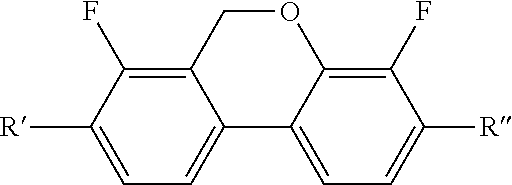Liquid crystal compounds containing dibenzopyran derivatives of naphthenic base and application thereof
a technology of dibenzopyran and dibenzopyran ring, which is applied in the field of liquid crystal compounds having dibenzopyran derivatives, can solve the problems of poor miscibility of alkyl-substituted dibenzopyran ring liquid crystal compounds
- Summary
- Abstract
- Description
- Claims
- Application Information
AI Technical Summary
Benefits of technology
Problems solved by technology
Method used
Image
Examples
example 1
Compound Shown in Formula I3-1
[0059]
[0060]Step 1
[0061]48 g (0.25 mol) of 2-fluoro-4-bromo-phenol, 30 g (0.275 mol) of bromoethane, 15 g (0.375 mol) of sodium hydroxide, 1 g of tetrabutylammonium bromide and 500 mL of acetone were put into a 1 L three-necked flask, and heated under reflux for 3 hours while stirring. After cooling to room temperature, the reaction mixture was poured into 500 mL of deionized water, and extracted with ethyl acetate twice. After liquid separation, the organic layers were combined, and then washed with 500 mL of deionized water once, followed by removal of solvent by evaporation under reduced pressure. The obtained solution was distilled under reduced pressure, and the fraction (750 Pa, 80° C.) was collected to obtain a colorless transparent liquid (1-a) 47 g, GC 97.5%, and yield 86%.
[0062]Step 2
[0063]46 g (0.21 mol) of the compound (1-a) and 150 mL of tetrahydrofuran were put into a 1 L three-necked flask, and stirred. Nitrogen gas was introduced into th...
example 2
Compound Shown in I4-2
[0078]
[0079]Step 1
was synthesized with the compound (1-a) as a starting material according to the steps 5, 6 and 7 in Example 1;
[0080]Step 2
was synthesized with the compound (1-d) as a starting material according to the steps 2 and 3 in Example 1;
[0081]Step 3
[0082]The target compound I4-2
was synthesized with the compounds (2-a) and (2-b) as starting materials according to the steps 8 and 9 in Example 1.
example 3
Compound Shown in Formula I1-1
[0083]
[0084]Step 1
[0085]60 g (0.20 mol) of 4-bromo-2-fluoroiodobenzene and 300 mL of tetrahydrofuran were added into a 1 L three-necked flask, and stirred. Nitrogen gas was introduced into the flask to replace air. The mixture was refrigerated to −78° C. in a cold bath with liquid nitrogen, 88 ml (0.22 mol) of 2.5M butyl lithium petroleum ether solution was added dropwise within half an hour. After reaction for half an hour, 25 ml of tetrahydrofuran solution containing 18.5 g (0.22 mol) of cyclopentanone was added dropwise at −78° C. within half an hour. The cold bath was removed, when the temperature of the solution was naturally increased to −20° C., the solution was poured into 5% hydrochloric acid aqueous solution for hydrolysis, and the pH value was adjusted to around 2. After liquid separation, the water layer was extracted with 500 ml×2 ethyl acetate, and then the organic layers were combined and washed with water to neutral, followed by removal ...
PUM
| Property | Measurement | Unit |
|---|---|---|
| temperature | aaaaa | aaaaa |
| temperature | aaaaa | aaaaa |
| temperature | aaaaa | aaaaa |
Abstract
Description
Claims
Application Information
 Login to View More
Login to View More - R&D
- Intellectual Property
- Life Sciences
- Materials
- Tech Scout
- Unparalleled Data Quality
- Higher Quality Content
- 60% Fewer Hallucinations
Browse by: Latest US Patents, China's latest patents, Technical Efficacy Thesaurus, Application Domain, Technology Topic, Popular Technical Reports.
© 2025 PatSnap. All rights reserved.Legal|Privacy policy|Modern Slavery Act Transparency Statement|Sitemap|About US| Contact US: help@patsnap.com



